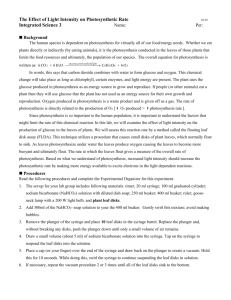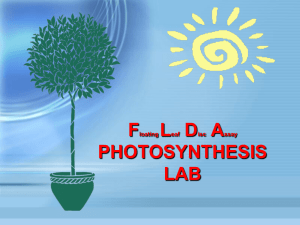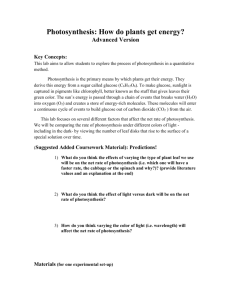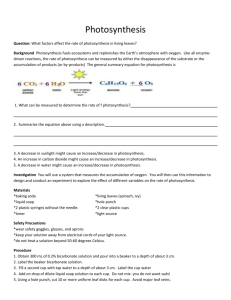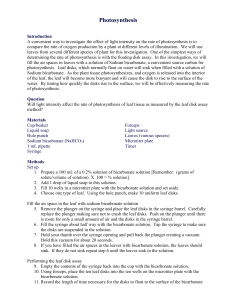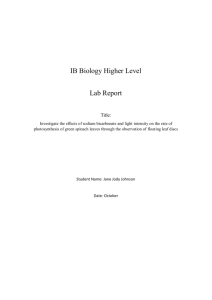Photosynthesis Lab
advertisement
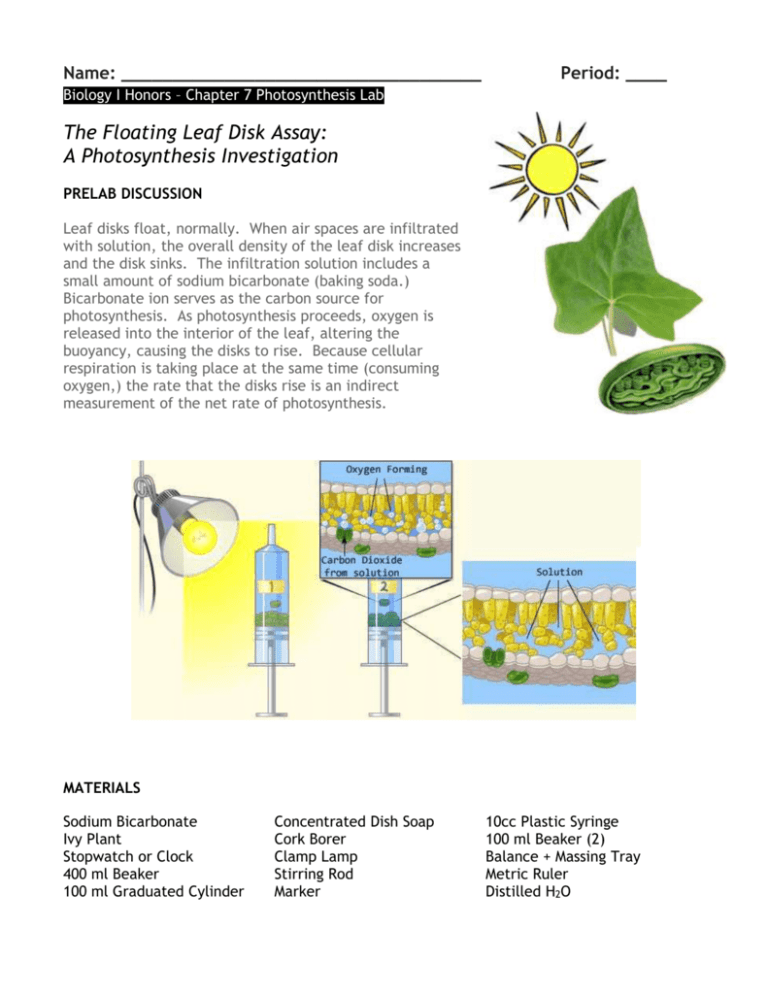
Name: ___________________________________ Period: ____ Biology I Honors – Chapter 7 Photosynthesis Lab The Floating Leaf Disk Assay: A Photosynthesis Investigation PRELAB DISCUSSION Leaf disks float, normally. When air spaces are infiltrated with solution, the overall density of the leaf disk increases and the disk sinks. The infiltration solution includes a small amount of sodium bicarbonate (baking soda.) Bicarbonate ion serves as the carbon source for photosynthesis. As photosynthesis proceeds, oxygen is released into the interior of the leaf, altering the buoyancy, causing the disks to rise. Because cellular respiration is taking place at the same time (consuming oxygen,) the rate that the disks rise is an indirect measurement of the net rate of photosynthesis. MATERIALS Sodium Bicarbonate Ivy Plant Stopwatch or Clock 400 ml Beaker 100 ml Graduated Cylinder Concentrated Dish Soap Cork Borer Clamp Lamp Stirring Rod Marker 10cc Plastic Syringe 100 ml Beaker (2) Balance + Massing Tray Metric Ruler Distilled H2O PROCEDURE Prepare 150 ml of 0.2 M Sodium Bicarbonate (NaHCO3) Solution 1. Add 2.5 g of baking soda to a clean 400 ml beaker. Molecular weight of NaHCO3 = 84 150ml (0.15 liter) of a 0.2 M solution... 0.2 x 84 x 0.15 = 2.52 g NaHCO3 2. Use a 100 ml graduated cylinder to attain 150 ml of distilled water. Pour this into the 400 ml beaker and stir. 3. Squirt a drop or two of liquid dish soap into your beaker. Preparing Specimens and Apparatus 4. Avoiding major veins, use the cork borer to cut eight uniform disks from your ivy leaves. 5. Remove the plunger and place the leaf disks into the syringe barrel. Replace the plunger being careful not to crush the leaf disks. Push on the plunger until only a small volume of air and leaf disk remain in the barrel (< 10% of barrel.) 6. Draw roughly 5 ml of sodium bicarbonate solution into the syringe. Tap the syringe to suspend the leaf disks in the solution. 7. Holding a finger over the syringe-opening, draw back a bit on the plunger to create a vacuum. Hold this vacuum for about 10 seconds. While holding the vacuum, swirl the leaf disks to suspend them in the solution. Let off the vacuum. The bicarbonate solution will infiltrate the air spaces in the leaf causing the disks to sink. You may need to repeat procedural step #7 again in order to get the disks to sink. If you have difficulty getting your disks to sink after about 3 evacuations, it is usually because there is not enough soap in the solution. Add another drop or two of soap and try again. 8. Pour the disks and solution into a clean 100 ml beaker. Using a clean 100 ml graduated cylinder, add 80 ml of 0.2 M sodium bicarbonate solution. Label this beaker “CO2.” 2 Setting Up a Control OBSERVATIONS 9. Rinse the 400 ml beaker and add 150 ml of distilled water. Squirt a drop or two of liquid dish soap into your beaker. DATA TABLE ONE 10. Cut and infiltrate eight more leaf disks using the new solution of soapy water (no sodium bicarbonate this time.) 11. Pour the disks and solution into a clean 100 ml beaker. Using the 100 ml graduated cylinder, add 80 ml of the soapy water solution. Label this beaker “No CO2.” Observing Photosynthesis 12. Clamp your light source about 6 inches (15.24 cm) above your beakers, or lay it on the lab table at that distance and start your stopwatch. 13. At the end of each 30 second interval, record the number of floating disks in Data Table One. After counting, gently swirl the disks to dislodge any that are stuck against the sides or bottom of the beaker. Continue until all of the disks are floating. Elapsed Number of Elapsed Number of Time Floating Disks Time Floating Disks 30s 10m 30s 1m 1m 30s 2m 11m 11m 30s 12m 2m 30s 12m 30s 3m 13m 3m 30s 13m 30s 4m 14m 4m 30s 14m 30s 5m 15m 5m 30s 15m 30s 6m 16m 6m 30s 16m 30s 7m 17m 7m 30s 17m 30s 8m 18m 8m 30s 18m 30s 9m 19m 9m 30s 19m 30s 10m 20m Extend the table if necessary. AFTER ALL DATA IS COLLECTED, CLEAN ALL MATERIALS AND LEAVE YOUR LAB STATION LIKE YOU FOUND IT! 3 RESULTS You may use the area below, or create a computer generated graph (eg. Excel) to display your results from Data Table One. Remember our discussions on variable location and titles when graphing. If using a computer program, staple your graph to this packet. 4 POST LAB QUESTIONS 1. Assume we had more time and wanted our disks to sink again. How could we achieve this? _________________________________________________________________________________ _________________________________________________________________________________ _________________________________________________________________________________ 2. Discuss the electromagnetic spectrum usage and how photosynthesis may be different if we used red cabbage in this experiment. _________________________________________________________________________________ _________________________________________________________________________________ _________________________________________________________________________________ 3. Compare and contrast the energy transfers that occur in plant’s mitochondria during cellular respiration and in their chloroplasts during photosynthesis. _________________________________________________________________________________ _________________________________________________________________________________ _________________________________________________________________________________ _________________________________________________________________________________ _________________________________________________________________________________ _________________________________________________________________________________ 4. Describe where, when, and why NADP+ is reduced to form NADPH during photosynthesis. _________________________________________________________________________________ _________________________________________________________________________________ _________________________________________________________________________________ _________________________________________________________________________________ _________________________________________________________________________________ _________________________________________________________________________________ 5 5. I selected the presence of sodium bicarbonate (source of CO2) as our independent variable for this investigation. List four other possible variables that could be tested in a controlled experiment demonstrating photosynthesis via the floating leaf disk assay. Develop a hypothesis for each potential experiment. Alternate Variable: ________________________________________________________________ Hypothesis: ______________________________________________________________________ _________________________________________________________________________________ _________________________________________________________________________________ Alternate Variable: ________________________________________________________________ Hypothesis: ______________________________________________________________________ _________________________________________________________________________________ _________________________________________________________________________________ Alternate Variable: ________________________________________________________________ Hypothesis: ______________________________________________________________________ _________________________________________________________________________________ _________________________________________________________________________________ Alternate Variable: ________________________________________________________________ Hypothesis: ______________________________________________________________________ _________________________________________________________________________________ _________________________________________________________________________________ This investigation was grown by Mr. Boylan using Brad Williamson’s Leaf Disk Assay Resource Page. 6
